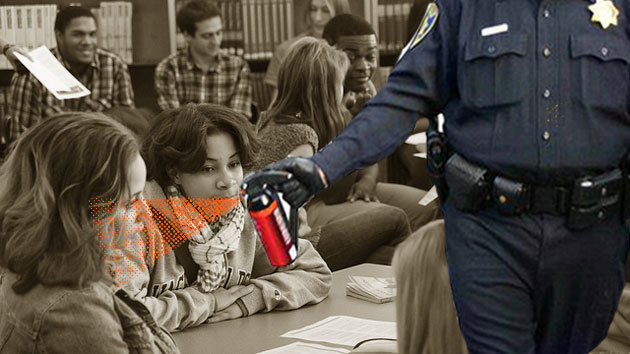
Students:<a href="https://www.flickr.com/photos/rdecom/8100955094/in/photolist-4FEYZg-pp7ZLZ-44nXcJ-dXEM6y-BMLyo-8429eX-aiJ5PJ-2AMvfX-ppnCDu-ppnD3L-ppnDGb-tHSUZ-2KRPV8-9Xro2v-4vqvwP-e8misG-5GqmLP-gJPMK5-72u3Kv-p7U5YH-6Pu9Yf-p7U2dB-cHS5v7-9kwDNu-dbVxr5-9vTVDX-dkRvHy-8qDT5E-p7V8aT-cT2fBE-9xNmT3-8429ea-dasaKD-8ZXMU1-cHS5nA-BMoJK-dMYP26-gJPZVN-pp7ZAZ-8LQgge-9vWXCs-i35dEX-8pTxwg-dCBVAe-q7v11-3DKEUg-Ma595-5SuFvq-8LK4vq-4Jud4e">U.S. Army RDECOM</a>/Flickr; Police Officer:<a href=""https://www.flickr.com/photos/donkeyhotey/6448613977/in/photolist-aMZNUe-aMZNUk-aMZNUr-9EELMN-7h5TqE-9oRySQ-67c3Wf-dLt8Qt-nQFT3N-aJDWna-5oAZf6-aHnDhn-aHRvPT-677jqe-aMZNUa-aJ9F6t-aRrt1X-eKDg6Y-aHjVgc-aHjVjD-7Gn5Mz-aR9Kbk-aZV9eR-6vFVFT-aX6dz6-dqFb4S-aPQQgv-aPQQgB-aLBj6K-5UGoNJ-a7bWh8-9W3nUB-a84UGM-aHjVqk-bBKKz8-boQQ5A-aKowWv-aJaVxr-aJaVJz-5SWVDq-bsbod5-otBzAy-dVpsrE-aJbbEi-dViSsz-oGbUM8-9xKWub-oGbVRc-oGqNGW-oGqPi5> DonkeyHotey </a>/Flickr
Update (10/1/15): A federal judge ruled on Thursday that the Birmingham Police Department violated students’ constitutional rights by pepper-spraying them to enforce school discipline. US District Court Judge Abdul Kallon found that officers working in the schools used a chemical spray called Freeze+P “even for the non-threatening infraction that is universal to all teenagers—i.e. backtalking and challenging authority. Frankly, the defendant S.R.O.s’ own testimony left the court with the impression that they simply do not believe spraying a student with Freeze +P is a big deal.” While Kallon believes there are some circumstances under which pepper spray could be warranted, he found that the officers did not try to decontaminate sprayed students after they had ceased to be a problem, leaving them to suffer continued physical effects from the chemicals.
When B.J. ambled into his fourth-period class at PD Jackson-Olin High School in Birmingham, Alabama, he could hardly have predicted that he would soon be handcuffed and crying, with pepper spray searing his eyes and nasal passages. Nor would he have guessed that by the day’s end he would be sequestered in a holding cell, vomiting from the chemicals.
Here’s how it happened, as described in court documents: One day in September 2010, “Mr. Cook,” a substitute teacher in the Birmingham City Schools, told B.J. (his initials), then a wiry 10th-grader, that he couldn’t be in the classroom until he tucked in his shirt. The teen obliged—dress violations were known to escalate at the school—but as he slipped back into the room a few minutes later, the sub heard someone among the rows mutter, “Fuck you, Mr. Cook.” Unsure who’d dissed him, he zeroed in on B.J. and summoned “Assistant Principal Gaston.”
Out in the hallway, Gaston subjected B.J. to a forced physical search. B.J. objected, and wriggled to loosen himself from the administrator’s grip. He tripped and landed facedown on the floor—whereupon Gaston took advantage of B.J.’s vulnerable position to check his back pockets. B.J.’s defiance led Gaston to call in backup. The kid soon found himself upright and pinned to a row of lockers by Gaston and a fellow administrator, “Assistant Principal Gates.”
That’s when School Resource Officer (SRO) Marion Benson arrived on the scene. Her face was the last thing B.J. saw before she blasted him with a cloud of pepper spray. He sunk to the ground in tears. If you try getting up, I am going to spray you again, she told him, her knee digging into B.J.’s back. She handcuffed him and led him to the main office.
“Woo! That’s the first macing of the year!” Mr. Gates remarked as the shackled teen sat in the office. Twenty minutes later, still wearing his chemical-infused clothes, B.J. was taken to the hospital, where staff said it was too late to do anything about the pepper spray, and then to a nearby detention center. He was held in a cell there until 7 p.m., when his grandmother came to pick him up.
This Was One of eight stories presented to US District Judge Abdul Kallon these past few weeks in a lawsuit whose outcome, which is expected in a decision Monday, may determine whether the city cops who work within the Birmingham school district as SROs can keep using pepper spray to break up fights and thwart what they consider disorderly conduct.
The suit, filed in 2010 by the Southern Poverty Law Center, alleges that eight students, including B.J., suffered physically and emotionally from unnecessary use of pepper spray. It names six SROs, as well as Birmingham Police Chief A.C. Roper. In 2012, a judge granted the case class action status, which means the outcome will henceforth apply to all of the district’s students.
“We want it to be declared unconstitutional because it allows officers to spray people, specifically students, without considering a wide variety of factors—such as whether they are in a school environment, the fact that they are in a closed environment, and the fact that these things that they are accusing kids of doing and acting on are actually just student misconduct issues,” says Ebony Howard, the SPLC staff attorney representing the students.
Since 2006, Howard says, there have been at least 110 pepper-spray incidents in the district. At the very least, her team wants the judge to insist upon written guidelines that state explicitly the circumstances in which it would be appropriate to reach for the Freeze +P chemical agent the officers use. “We want training for these officers on adolescent development, de-escalation techniques, conflict management, and conflict resolution,” she told me. “Basically, we want them to be trained on how to actually be SROs, and to work in an environment where they have the tools to help calm down a conflict that do not involve spraying chemicals in kids’ faces.”
The modern police presence in schools emerged from the same crack-era hysteria that brought us mandatory minimums, three-strikes laws, and an explosion of the US prison population. During the early-to-mid-1990s, with juvenile arrests for violent crime on the rise and legislators shrilling about the so-called juvenile superpredators, more and more schools contracted with police departments to put uniformed officers on campus.
Looking back in 2013, the Congressional Research Service (CRS) reported that about 25 percent of existing SRO programs were originally created because of media-incited fears, and another 25 percent because of school rowdiness and vandalism. Only about 4 percent of districts and law enforcement agencies cited the level of violence in local schools as the motivation for initiating a program. (The rest of the programs were created for “other” reasons, such as a school taking advantage of grant money or taking part in a drug awareness program.)
The number of school resource officers deployed nationwide continued to surge into the early oughts. According to the CRS, there were about 12,000 SROs in 1997—by 2003, the number of officers had grown to nearly 20,000. When the Birmingham district began putting local police in its schools in 1996, it made what the authors of a Justice Department assessment would later describe as a “frequent and destructive mistake.” Like many other districts, it enlisted the cops without first working out their roles and responsibilities in a school setting. “When programs fail to do this, problems are often rampant at the beginning of the program—and often persist for months and even years,” the 2005 assessment warned.
A few years after that report appeared, the district’s then-interim superintendent Barbara Allen began to take notice of what had become an increasingly troublesome partnership. In the absence of school-appropriate guidelines, police were stepping in to deal with minor rulebreaking—sagging pants, disrespectful comments, brief physical skirmishes. What previously might have resulted in a detention or a visit to the principal’s office was replaced with excruciating pain and temporary blindness, often followed by a trip to the courthouse.
Indeed, in 2007-08, a whopping 513 students from the district landed in Jefferson County Family Court. This represented 82 percent of the referrals from schools to court in the county, even though only 25 percent of Jefferson County’s public school students attend Birmingham City Schools. Brian Huff, then a presiding judge, complained to the Birmingham News that fewer than 1 in 10 of those kids ever should have been arrested.
Allen knew she had a real problem on her hands when she learned that multiple school officials were heading to court at least once a week. “Other school systems aren’t arresting kids for small things; they handle it from within,” she told the Birmingham News in the spring of 2009. “We call the police.” The district’s high schools had a total of 12 SROs, plus two sergeants and a lieutenant, patrolling their hallways and grounds. (The same Birmingham News article quoted Mayor Larry Langford saying he would “pull officers off the streets and put them in the schools,” after the mayor had encountered graffiti and disrespectful students during a high school visit.)
After meeting with Judge Huff that summer to discuss the problem, Allen took action. That December, she persuaded the Birmingham PD to sign a “collaborative agreement,” which fleshed out, somewhat, the role of police in the schools. Notably, it acknowledged that pepper spray and cuffs were being used for minor offenses, and that teachers and administrators should be the ones addressing noncriminal violations in the future.
But the agreement had fatal flaws: For one, it didn’t detail how officers should act when their intervention was deemed necessary, so officers continued to behave in schools as they would on the streets. The document also had an “exceptional circumstances” clause, which gave police employees the right to exercise their discretion. The defense in the SPLC lawsuit is now pointing to this provision to argue that the officers have the green light to arrest and deal with students as they see fit.
IF POLICE OFFICERS happened upon a couple of 16-year-olds fighting off campus, they would be allowed to use pepper spray, so why would it be any different on a school campus? That’s a question posed by Michael Choy, the police department’s defense attorney, during the second week of the trial.
The court, Choy said, must remember that these students “are not children” but, rather, “big adults.” One of the former students in the case, he emphasized, would be testifying by video from a New York prison. The implicit message: These kids were the bad apples.
Choy’s comment was “very disturbing,” says Dennis Parker, head of the American Civil Liberties Union’s racial justice program. It reminds him of how police in Ferguson, Missouri, tried to portray Michael Brown as a hoodlum after one of their own shot the unarmed teenager. The tactic distracts from the question at hand, which is “whether or not the police or the SRO were acting in an appropriate way.”
The criminalization of minor student misconduct, and the effect it has on high school kids, is a topic Thomas Pedroni, an associate professor at Wayne State University’s College of Education, is studying in partnership with the ACLU. “Police set up a different environment in a school,” he explains. “It becomes less focused on nurturing and caring and growing, and more focused on control…It’s sort of tough in the environment of police presence to go, ‘Oh, no, we’re really a community of trust.'”
In many ways, Pedroni adds, the school-to-prison pipeline could be renamed the prison-to-prison pipeline, given how so many schools have adopted the sterile, suspicion-first qualities of juvenile detention centers.
This notion of a dehumanized high school experience played a central role in Howard’s legal strategy, especially as she aimed to convey the ripple of effects of a zero-tolerance school culture.
“When you use a tactic like chemical sprays in schools, what you do is you teach a kid who has been sprayed, a kid who may have been accidentally sprayed, a kid who saw another kid get sprayed, as well as a kid who just knows about the use of the chemical—all of those kids learn to distrust law enforcement officers,” Howard says. “They learn that they will not be treated fairly.”















